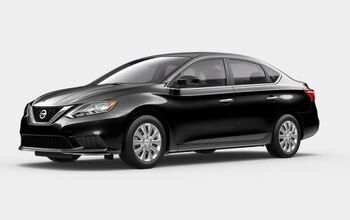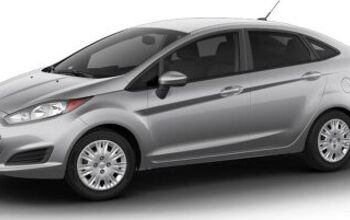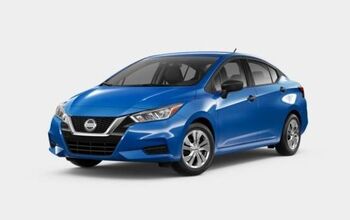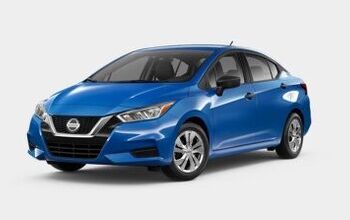Ace of Base: 2019 Nissan Versa Sedan S

Look, there are people who buy cars simply for transportation purposes. Yes, I know it’s hard to believe, especially for folks like you and I who are of the opinion that a bright-green Dodge Demon is just the ticket for a daily office commute.
Small, largely style-free sedans have been the mainstay of the affordable end of the market for decades. Despite the wholesale abandonment of that segment by certain automakers, there are still plenty of players in the game. Call ‘em the Econ Majors.
Matt ably told us about all trims of the 2019 Nissan Versa Sedan in yesterday’s news cycle. The base trim, labeled with a letter thanks to Nissan’s S-SV-SL naming convention, is now priced at $12,360, which represents a $50 hike over last year’s mid-year refresh.
Yes, mid-year. There are 2018.5 models of the Versa Sedan that differ in feature content compared to the 2018. Be sure to check your notes at Barrett-Jackson in thirty years’ time, folks.
The Versa Sedan was upgraded in mid-2018 with the addition of a standard RearView Monitor and an upgraded audio system. The new audio system includes a 7.0-inch color touchscreen, streaming audio via Bluetooth, a USB connection port for smartphones and other compatible devices, plus an Aux port. The 2019 retains all these goodies.
All base model 2019 Versa Sedans are equipped with a 109-horsepower 1.6-liter four-banger with a manual transmission. Fifteen-inch tires are mounted on steel wheels. Rear drums are a disappointment for this author, although there are plenty in the audience who feel those units are more than sufficient with the bonus of commanding fewer shekels at replacement time. Those people are free to be dead wrong.
Passengers will enjoy an abundance of cup holders and the all-important air conditioning. The steering wheel tilts and lights up its audio controls like Las Vegas. Color-keyed side-view mirrors are power operated.
There remains the issue of Versa’s appearance, as the designer’s styling choices have made the diminutive sedan look like a Beirut taxi. Its elongated taillights are uncohesive and, combined with a large rear overhang, seems to give it a droopy butt. This visual chicanery makes it appear too tall and narrow, as if it’s standing on tippy-toes looking for something on top of the fridge. I will point out this PR pic features a car with mismatched rims, if not in the reflection.
Still, under thirteen grand for a small sedan that’s not equipped like a penalty box and has air conditioning? That’s an attractive value. Ford’s base Fiesta is two grand more. Chevy’s base Sonic sedan? A three grand premium. Econ major, indeed.
[Images: Nissan]
Not every base model has aced it. The ones which have? They help make the automotive landscape a lot better. Any others you can think of, B&B? Let us know in the comments. Naturally, feel free to eviscerate our selection.
The model above is shown in American dollars with American options and trim, absent of destination charges and available rebates. As always, your dealer may sell for less.

Matthew buys, sells, fixes, & races cars. As a human index of auto & auction knowledge, he is fond of making money and offering loud opinions.
More by Matthew Guy
Latest Car Reviews
Read moreLatest Product Reviews
Read moreRecent Comments
- W Conrad I'm not afraid of them, but they aren't needed for everyone or everywhere. Long haul and highway driving sure, but in the city, nope.
- Jalop1991 In a manner similar to PHEV being the correct answer, I declare RPVs to be the correct answer here.We're doing it with certain aircraft; why not with cars on the ground, using hardware and tools like Telsa's "FSD" or GM's "SuperCruise" as the base?Take the local Uber driver out of the car, and put him in a professional centralized environment from where he drives me around. The system and the individual car can have awareness as well as gates, but he's responsible for the driving.Put the tech into my car, and let me buy it as needed. I need someone else to drive me home; hit the button and voila, I've hired a driver for the moment. I don't want to drive 11 hours to my vacation spot; hire the remote pilot for that. When I get there, I have my car and he's still at his normal location, piloting cars for other people.The system would allow for driver rest period, like what's required for truckers, so I might end up with multiple people driving me to the coast. I don't care. And they don't have to be physically with me, therefore they can be way cheaper.Charge taxi-type per-mile rates. For long drives, offer per-trip rates. Offer subscriptions, including miles/hours. Whatever.(And for grins, dress the remote pilots all as Johnnie.)Start this out with big rigs. Take the trucker away from the long haul driving, and let him be there for emergencies and the short haul parts of the trip.And in a manner similar to PHEVs being discredited, I fully expect to be razzed for this brilliant idea (not unlike how Alan Kay wasn't recognized until many many years later for his Dynabook vision).
- B-BodyBuick84 Not afraid of AV's as I highly doubt they will ever be %100 viable for our roads. Stop-and-go downtown city or rush hour highway traffic? I can see that, but otherwise there's simply too many variables. Bad weather conditions, faded road lines or markings, reflective surfaces with glare, etc. There's also the issue of cultural norms. About a decade ago there was actually an online test called 'The Morality Machine' one could do online where you were in control of an AV and choose what action to take when a crash was inevitable. I think something like 2.5 million people across the world participated? For example, do you hit and most likely kill the elderly couple strolling across the crosswalk or crash the vehicle into a cement barrier and almost certainly cause the death of the vehicle occupants? What if it's a parent and child? In N. America 98% of people choose to hit the elderly couple and save themselves while in Asia, the exact opposite happened where 98% choose to hit the parent and child. Why? Cultural differences. Asia puts a lot of emphasis on respecting their elderly while N. America has a culture of 'save/ protect the children'. Are these AV's going to respect that culture? Is a VW Jetta or Buick Envision AV going to have different programming depending on whether it's sold in Canada or Taiwan? how's that going to effect legislation and legal battles when a crash inevitibly does happen? These are the true barriers to mass AV adoption, and in the 10 years since that test came out, there has been zero answers or progress on this matter. So no, I'm not afraid of AV's simply because with the exception of a few specific situations, most avenues are going to prove to be a dead-end for automakers.
- Mike Bradley Autonomous cars were developed in Silicon Valley. For new products there, the standard business plan is to put a barely-functioning product on the market right away and wait for the early-adopter customers to find the flaws. That's exactly what's happened. Detroit's plan is pretty much the opposite, but Detroit isn't developing this product. That's why dealers, for instance, haven't been trained in the cars.
- Dartman https://apnews.com/article/artificial-intelligence-fighter-jets-air-force-6a1100c96a73ca9b7f41cbd6a2753fdaAutonomous/Ai is here now. The question is implementation and acceptance.





































Comments
Join the conversation
We have a ‘17 Versa S 5M and absolutely love it. I picked it up as a backup car for my family. We have a soon to be driving teenager and with this family of 6, not every body goes shopping together all the time. We have a Quest for that business. It returns good mileage, AC is ice cold, trunk is huge and backseat room is incredible for a subcompact, very roomy. Sure, it’s an appliance but with the stick it is fun to drive and lowering the recommended tire PSI eliminates the drifty handling it can exhibit on the freeway. Love it.
I guess I am just a bottom feeder but I think I would like a Note 5-speed if they gave it the 125 horse engine from the Kicks.